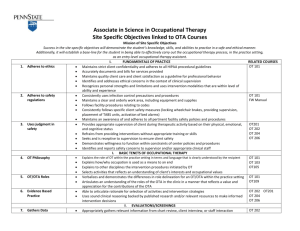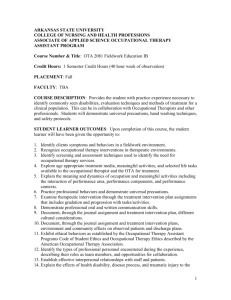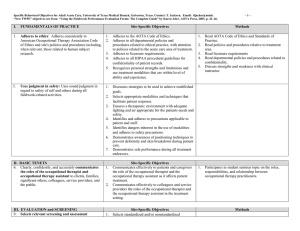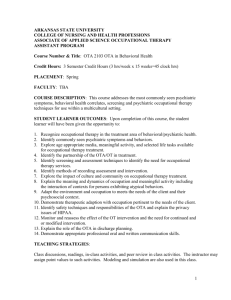Penn State Site Specific Learning Objectives (FW II)
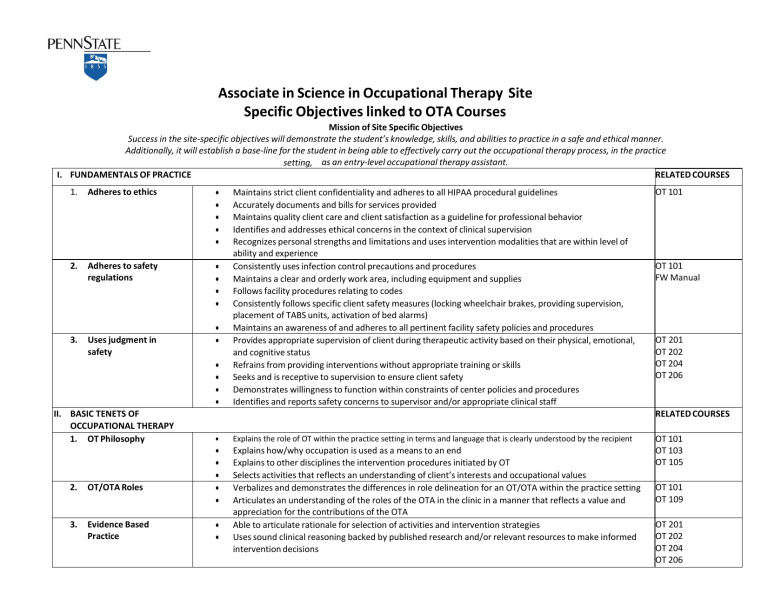
Associate in Science in Occupational Therapy Site
Specific Objectives linked to OTA Courses
Mission of Site Specific Objectives
Success in the site-specific objectives will demonstrate the student’s knowledge, skills, and abilities to practice in a safe and ethical manner.
Additionally, it will establish a base-line for the student in being able to effectively carry out the occupational therapy process, in the practice setting, as an entry-level occupational therapy assistant.
I.
FUNDAMENTALS OF PRACTICE FUNDAMENTALS OF PRACTICE RELATED COURSES
1.
Adheres to ethics OT 101
2.
Adheres to safety regulations
3.
Uses judgment in safety
II.
BASIC TENETS OF
OCCUPATIONAL THERAPY
1.
OT Philosophy
• Maintains strict client confidentiality and adheres to all HIPAA procedural guidelines
• Accurately documents and bills for services provided
• Maintains quality client care and client satisfaction as a guideline for professional behavior
• Identifies and addresses ethical concerns in the context of clinical supervision
• Recognizes personal strengths and limitations and uses intervention modalities that are within level of ability and experience
• Consistently uses infection control precautions and procedures
• Maintains a clear and orderly work area, including equipment and supplies
• Follows facility procedures relating to codes
• Consistently follows specific client safety measures (locking wheelchair brakes, providing supervision,
• placement of TABS units, activation of bed alarms)
Maintains an awareness of and adheres to all pertinent facility safety policies and procedures
• Provides appropriate supervision of client during therapeutic activity based on their physical, emotional, and cognitive status
• Refrains from providing interventions without appropriate training or skills
• Seeks and is receptive to supervision to ensure client safety
• Demonstrates willingness to function within constraints of center policies and procedures
• Identifies and reports safety concerns to supervisor and/or appropriate clinical staff
BASIC TENETS OF OCCUPATIONAL THERAPY
OT 101
FW Manual
OT 201
OT 202
OT 204
OT 206
RELATED COURSES
OT 101
OT 103
OT 105
2.
OT/OTA Roles
3.
Evidence Based
Practice
•
•
• Explains the role of OT within the practice setting in terms and language that is clearly understood by the recipient
Explains how/why occupation is used as a means to an end
Explains to other disciplines the intervention procedures initiated by OT
• Selects activities that reflects an understanding of client’s interests and occupational values
• Verbalizes and demonstrates the differences in role delineation for an OT/OTA within the practice setting
• Articulates an understanding of the roles of the OTA in the clinic in a manner that reflects a value and
• appreciation for the contributions of the OTA
Able to articulate rationale for selection of activities and intervention strategies
• Uses sound clinical reasoning backed by published research and/or relevant resources to make informed intervention decisions
1: Fundamentals of Practice and Basic Tenets of Occupational Therapy
OT 101
OT 109
OT 201
OT 202
OT 204
OT 206
III.
EVALUATIONS/SCREENINGS EVALUATIONS/SCREENINGS
1.
Gathers Data
2.
3.
4.
5.
Administers Assessment
Interprets
Reports
Establish Goals
• Appropriately gathers relevant information from chart review, client interview, or staff interaction regarding the client’s functional status, home environment, etc.
• Selects and filters relevant and important information from all data collected
• With appropriate supervision and instruction, administers assessments relating to occupational therapy performance
• Demonstrates an understanding of FIM language and terminology to assess areas of self-care
• Accepts responsibility and is aware of the importance of accurate assessment
• Observes standardized techniques in using standardized assessment tools
• Determines correct FIM levels based on client performance
• Able to objectively select pertinent data from assessment to develop an accurate profile of the client’s strength and weaknesses
• Reports ADL assessment information to the occupational therapist in a clear, accurate, and concise
• manner
• Completes necessary paperwork based on assessment
• Reports performance data objectively
• Collaborates with the OTR in establishing/modifying functional goals
• Grades and/or changes activity or method to achieve intervention goal
IV. INTERVENTION
1.
Plans Intervention
2.
Selects Intervention
INTERVENTION
• Completes thorough intervention plans for clients
• Prioritizes problem areas and addresses foundation skills needed for intervention progression
• Chooses graded activities and/or preparatory activities that will be most effective in maximizing the client’s occupational performance and allow for ongoing assessment of the client’s functional capacity and readiness for discharge
•
• Chooses occupations that motivate and challenge the clients
Selects activities that are appropriate based on established goals
3.
Implements
Interventions
RELATED COURSES
OT 202
OT 204
OT 206
OT 202
OT 204
OT 206
OT 103
OT 105
OT 202
OT 204
OT 206
OT 202
OT 204
OT 206
OT 202
OT 204
OT 206
OT 202
OT 204
OT 206
OT 201
OT 201
OT 202
OT 204
OT 206
RELATED COURSES
OT 202
OT 204
OT 206
OT 201
4.
Activity Analysis
• Schedules clients for ADLs as appropriate based on their current level of function and need for updated FIM scores
• Recognizes appropriateness for specific tasks based on client’s current physical, emotional, and cognitive
• Offers occupations (occupation-based activity, purposeful activity, preparatory methods) that match the client’s performance skills, patterns, context, activity demands, and client factors
• Grades activity to motivate and challenge the client in order to facilitate progression of goals
• Appropriately recognizes the inherent qualities of a task in order to match to the client’s needs
• Demonstrates the ability to identify more than one appropriate strategy for a given problem area
• Appropriately revises and adjusts selected activities to adapt to a change in the client’s condition
OT 103
OT 105 (groups)
OT 107
V.
5.
Therapeutic Use of Self
6.
Modifies Intervention
Plans
COMMUNICATION
1.
Verbal/Nonverbal
Communication
• Incorporates empathy and understanding during the intervention and training with clients and families
• Develops and maintains rapport with clients, families, and/or significant others that enhances the therapeutic relationship
• Develops and maintains rapport with clients that enhances the therapeutic relationship
• Identifies barriers to the client’s progression and makes necessary changes to the intervention plan
• Grades and modifies intervention to allow for progression in functional status without frustration
• Recognizes changes in the client’s physical, mental, emotional, or cognitive status and adjusts the intervention plan as appropriate
• Demonstrates the ability to be flexible with intervention plans and adapts to changes in the clients in a timely manner
COMMUNICATION
• Clearly communicates the definition of OT to clients and families
• Clearly articulates client status updates with clients, families, and other staff
• Presents oneself in a professional manner through body language, posture, eye contact, etc. with clients, families, and other staff
Across the
Curriculum
OT 202
OT 204
OT 206
OT 201
RELATED COURSES
Across the curriculum
2.
Written Communication • Prepares clear and accurate reports of client participation and progress
• Uses proper spelling, punctuation, and grammar
• Produces all written communication in a timely manner
• Uses facility approved abbreviations
• Reports unusual and/or critical information in writing
Across the curriculum
VI.
PROFESSIONAL BEHAVIORS PROFESSIONAL BEHAVIORS
1.
Self-Responsibility
2.
Responds to Feedback
RELATED COURSES
• Collaborates with appropriate staff to participate in additional learning opportunities.
• When appropriate, initiate intervention, client updates, ADL scheduling, clinic clean, etc. without instruction from supervisor to do so
• Defines personal expectations and goals for the affiliation
• Self-directed in determining learning strengths and challenges
OT 103
OT 105
OT 107
OT 202
OT 204
OT 206
• Appropriately acknowledges feedback, instruction, concern from supervisor and modifies behavior as needed in a timely manner
• Adjusts behavior in response to cues and directions from supervisor, staff, and the environment
• Incorporates feedback from supervisor into intervention planning and intervention implementation and discuss outcomes
Across the curriculum
Professional
Behaviors Interviews
3.
Work Behaviors Across the curriculum
4.
Time Management
• Demonstrate consistent work behaviors of timeliness, preparedness, dress, and communication
• Arrives on time and consistently completes work assignments on time
• Demonstrates effective time management regarding intervention implementation and documentation
• Organizes intervention and non-intervention responsibilities in order to ensure that responsibilities are completed in a timely and professional manner
Across the curriculum
5.
Interpersonal Skills
•
•
•
Demonstrates appropriate work place communication with supervisor, clients, families, and staff
Maintains appropriate personal/professional role delineation among staff and clients
Consistently maintains professional behaviors in the workplace, including, but not limited to, professional appearance, showing response for other professionals, and presenting in a professional, confident manner
Across the curriculum
6.
Cultural Competence
•
•
• Demonstrates an understanding and tolerance of diversity among socio-cultural, socioeconomic, spiritual, and lifestyle choices
Respectful and open to diverse backgrounds and ideas in the workplace
Seeks to understand the client’s perspective and context when collaborating in intervention
• Careful to not impose one’s own beliefs and values on clients
Evaluations/Screenings, Intervention, Communication, and Professional Behaviors
OT 101
OT 103
Across the curriculum
• AOTA Site Specific Objectives: AOTA Site Specific Objectives can be found at this link
• AOTA (2008). Occupational Therapy Practice Framework. Bethesda: AOTA Press.
• Creapeau, E.B. ,Cohn, E.S. ,Schell, B.B.(2009). Wiilard and Spackmans Occupational Therapy. Philadelphia: Lippincott, Williams and Williams.
O: July 2012 R: August 2013
